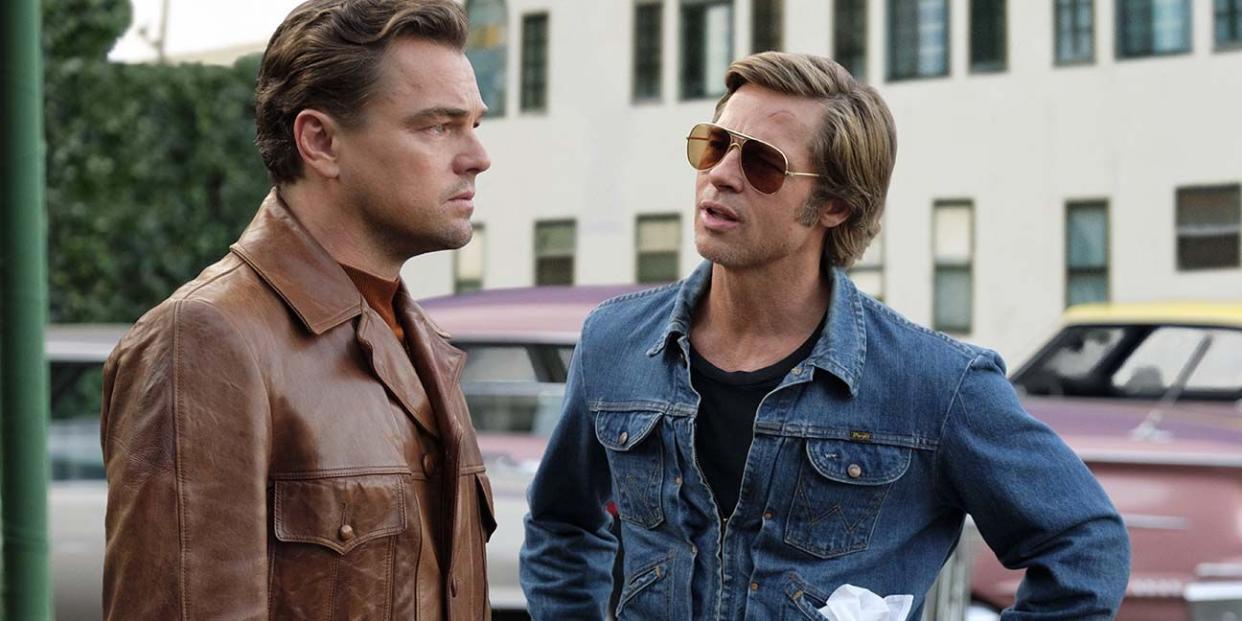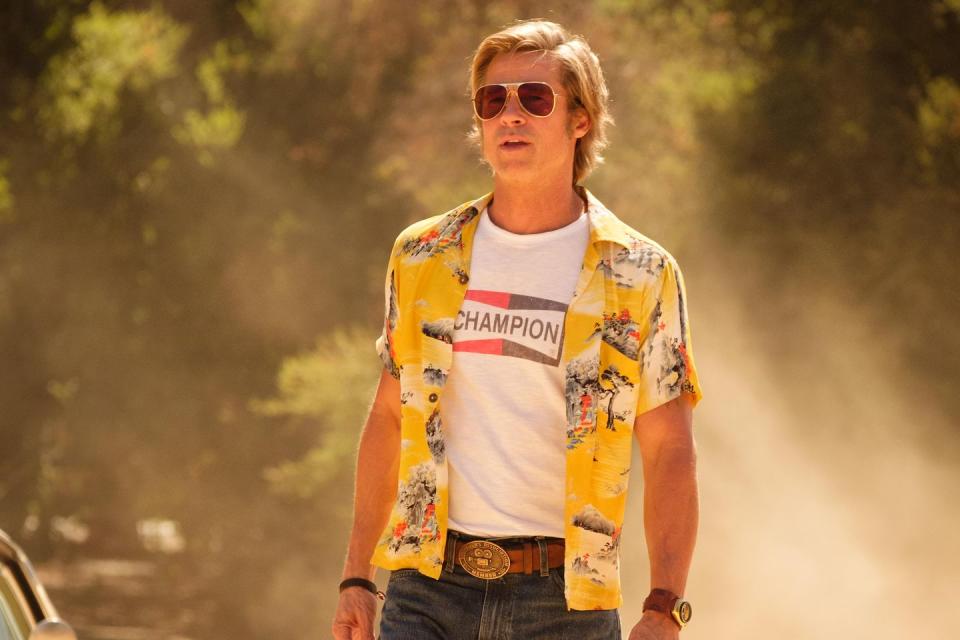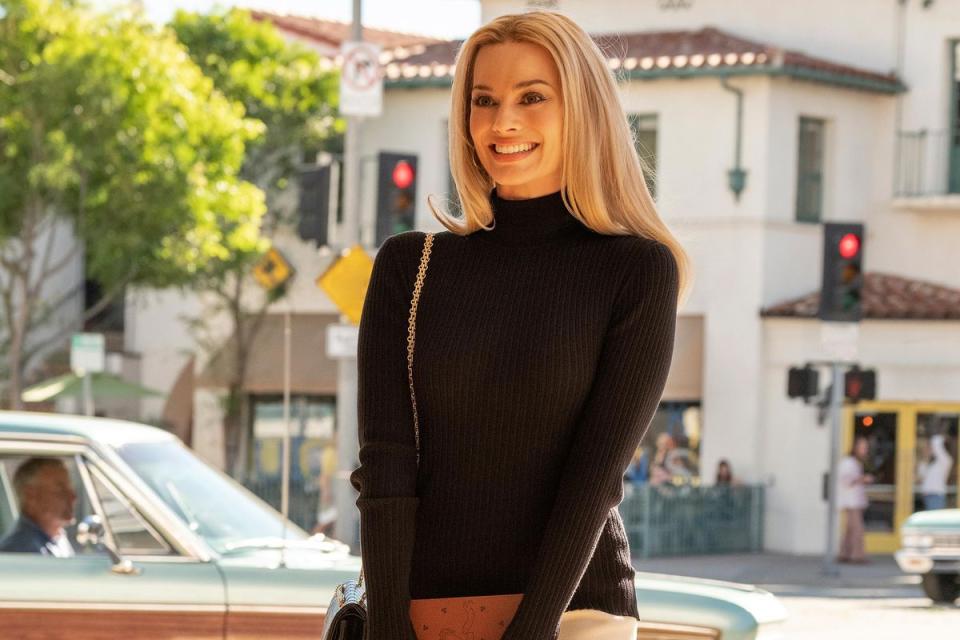The Ending of ‘Once Upon a Time...In Hollywood,’ Explained

Quentin Tarantino's Once Upon a Time... In Hollywood is nominated for 10 Oscars
It's expected to earn Brad Pitt, who plays Cliff Booth, his first Academy Award for acting.
You might be confused by the movie's ending—that's OK. We've got you covered.
Warning: this story includes spoilers for the ending of Once Upon a Time... In Hollywood. If you haven't seen it yet and plan to, you should probably stop reading right now!
By now, Quentin Tarantino's Once Upon a Time...In Hollywood is no secret to anyone. In fact, it's nominated for 10 Oscars, including Tarantino himself (for Best Director and Best Original Screenplay), and stars Leonardo DiCaprio and Brad Pitt (the heavy favorite to win his first Academy Award for acting in the Best Supporting Actor category). At first, the movie's plot was kept secret—all we knew was that it somehow involved The Manson Family, and that DiCaprio and Pitt would be playing fictional actor Rick Dalton and stuntman Cliff Booth, respectively (Margot Robbie plays Sharon Tate).
But the movie has now been out for more than six months, and people have had time to see, digest, and understand it. While Tarantino's repertoire of films often goes to extreme places, Once Upon a Time often feels restrained; the warmth throughout is rare within this director's movies.
That being said, it also has an ending that feels almost engineered to spark discussion, and it's a discussion we're happy to be a part of. With the idea of Old Hollywood, and movie stardom as central themes, it's a movie that Tarantino—a movie buff through and through—felt destined to make, and the ending seems to speak strongly to that love of film.
The movie is not only an exploration of two lead characters unlike any others in Tarantino's repertoire, but also a statement about violence, an era, movies, and Hollywood itself. Let's get into it.
What set the stage?
Once Upon a Time... In Hollywood takes place in three distinct time periods: the first, where we first meet Rick and Cliff, establishes the characters. Rick is a former TV star who's foray into movies didn't go as planned, and he's desperately trying to make his way back, settling for a series of TV guest spots playing the villain. Cliff, who may or may not have killed his wife, is a cool breeze stuntman who drives Rick everywhere and always has his back. Where Rick is an insecure mess, feeling older and with less of a place in the industry every day, Cliff carries an effortless confidence everywhere he goes. Sharon Tate, a carefree, kind-hearted, up-and-coming actress keeps company with her husband, the director Roman Polanski (Rick lives next door to the couple, and desperately wants to work with Polanski), and celebrity hairstylist Jay Sebring.
The second time period finds Rick and Cliff separated, as Rick is filming a guest spot on a TV show and Cliff has blown his relationship with the show's stunt coordinator in the past (a brilliant flashback sequence shows Cliff fighting a hyper-confident Bruce Lee, played by Mike Moh). While Rick goes through the motions to get his TV part (on the real-life show Lancer) right, Cliff picks up a hitchhiker named Pussycat who turns out to be a member of the Manson Family, who are squatting at Spahn Ranch. As Cliff used to film there with Rick, he heads over to check it out. He feels like something isn't right, and after a few wild happenings, he flees. Sharon, meanwhile, spends the afternoon listening to music and heading to a screening of her own new release movie, The Wrecking Crew, in which she stars alongside Dean Martin. She takes in the audience's reaction to her work with much enjoyment.
So what actually happened in the Once Upon a Time...In Hollywood ending?

The final timeframe is one that might ring a bell: August 8, 1969. In reality, this was the night when Manson's crew—Tex Watson, Susan Atkins, Patricia Krenwinkel, and Leslie Van Houten—ransacked Tate's house, brutally murdering her along with Sebring and three others, and writing on the walls in pig's blood.
The movie's depiction of this night, though, is significantly different—Rick and Cliff's involvement, apparently, make a significant dent in the way things play out.
Following his role on Lancer in the last part of the movie, Rick got a number of opportunities to make Western films in Italy, where he's spent the last six months, also marrying an Italian actress named Francesca. Upon his return to Hollywood, he and Cliff come to a mutual agreement that they can't continue to work together anymore, and plan to have one last night of heavy drinking together.
As we see their night, it's presented parallel to the night of a very pregnant Tate, along with Sebring, and two of their other friends having drinks at a Mexican restaurant. As both parties return home, a lingering feeling creeps in that Watson and the rest of the Manson crew will inevitably show up, and do what history knows they eventually did. But this is Tarantino. And, as fans of his past films know, he doesn't play by those rules.
When Watson, Atkins, Van Houten, and Krenwinkel show up in Rick and Sharon Tate's cul de sac, we see them lingering in the street in a car with a loud muffler. A very drunk and irate Rick goes out, margarita blender in hand, to chew them out. He yells at them to stay off his private road, and for a moment they're stunned.
At this point, our twist hits: Manson told the four to ransack and destroy Tate's house, as it was formerly the house that Terry Melcher, a music producer who refused to work with him, lived in. But when Atkins recognized Rick from his canceled Western, Bounty Law, the group changes their mind, deciding it would be more impactful if they murdered this actor they all of a sudden recognized.
They enter the house armed with guns and knives, planning to kill Rick and Cliff, but Cliff—who's smoked a cigarette dipped in acid sold to him earlier—fights them off, killing Watson and Van Houten in brutal fashion with the help of his dog. Rick, meanwhile, is out back floating in the pool listening to his radio when an injured Atkins flies through and lands into his pool screaming maniacally. He's startled, and runs back into his house and grabs his flamethrower—established earlier as a prop that he learned to use for a movie role—and roasts her up.
As the movie ends, Jay Sebring asks Rick through the fence what in the world just happened. Rick, startled that he—and Sharon—know who he is, goes over next door for a drink, and all, seemingly, is well in Hollywood.
What it all means:
With the way Tarantino handled WWII in Inglorious Basterds—Hitler gunned down by a machine gun, and a Jewish woman whose family was killed by Nazis trapping the Third Reich in a movie theater and burning them to death—and slave plantations in Django Unchained—a former slave-turned-bounty hunter taking down an entire plantation—we should have seen the altered ending of Once Upon a Time...In Hollywood coming.
Yet when Tarantino starts playing with history once again, it still plays as a shock—from the moment Watson, Atkins, and Van Houten enter Rick's house, it inevitably feels like sooner or later, the story will course-correct its way back to reality. But Tarantino's revenge fantasy tendencies overrule the rest here, and about halfway through the scene we start realizing what's happening. Rick and Cliff are our proxies—they're Tarantino's way to alter reality. Everyone knows what happened; what he's interested in is instead what could have happened.
Rick spends the entire movie feeling left behind by the industry, but it's the fact that he's recognized by these murderous young people that anything ends up changing for the better at all. If Tarantino is presenting the idea of feeling less important with every passing day, the idea that those past accomplishments aren't quickly forgotten is surely one that's also constantly present—and plays a vital role in the end of the film. When it's all said and done, Jay Sebring is the one who recognizes, and talks to, Rick, not the other way around. They've known him all along—he wasn't as forgotten, or as washed up, as he had so thought.
What about Sharon Tate?

Then there's the Sharon Tate of it all. The movie makes sure to present her as almost the human personification of the goodness and innocence of the late '60s. Margot Robbie doesn't have a ton of dialogue, and maybe some will criticize that decision from Tarantino. But Robbie plays the part so strongly, even just with body language and facial expressions, that everything she represents is crystal clear. There's a lot of evil out there—we see that with Watson, and the rest of the family. But in keeping focus on Tate, we see the innocence, the talent, and the sheer love for the medium of film that existed too.
Tate's legacy, in many ways, has been taken by Manson. By killing her, that has always been where her story has ended; rather than talking about her movies with Dean Martin, or her marriage to an acclaimed director, she's forever been defined by the cult that took her life. Tarantino shows her life here for what it was, and what it could have been—someone who wants not only to bring happiness to friends and strangers alike (she even picks up a random hitchhiker just to be nice), but someone who can represent the joy of what film by and large can be, do, and represent. Just like Sharon, you can saunter into a movie theater on any given afternoon, and joy can come from that. It's a reality that exists now, existed then, and will exist forever—no matter how hard they try, a murderous cult can't take that away from anyone.
So when Tarantino presents this love letter to Hollywood, he shows the good, the bad, and the ugly of it all. We see how the ups and downs of working in film affect Rick, how it affects Cliff, and how it affects Sharon. But we see, too, how it also links everyone at a deeper, core level. Sharon and Rick don't know each other—but in the end, even though they haven't met yet, they do. It's not necessarily the traumatic experience that Rick's just gone through, literally killing a home intruder with a flamethower, that links them—it's the fact that she recognizes him from a canceled TV western. Sharon has no idea what alternate reality Tarantino's Rick/Cliff timeline has spared her from, but her pure spirit greets him with a hug, inviting him in for a drink.
And that's what Tarantino wants to do with the entirety of Once Upon a Time...In Hollywood. We know what really happened on that night in August, and so does everyone watching the movie—it's why the ending plays so strongly. We hear 'Charles Manson,' and we even see him on screen for, what, 10 seconds? But we know what's coming. Or so we think.
Which is why Tarantino's revenge fantasy ending works so damn well here; it's the ending we truly can't see coming, even though this director has shown us time and time again that he's willing to go beyond reality to tell the story he wants to tell.
And just this time, for one night in Hollywood, that story had a happy ending.
You Might Also Like

